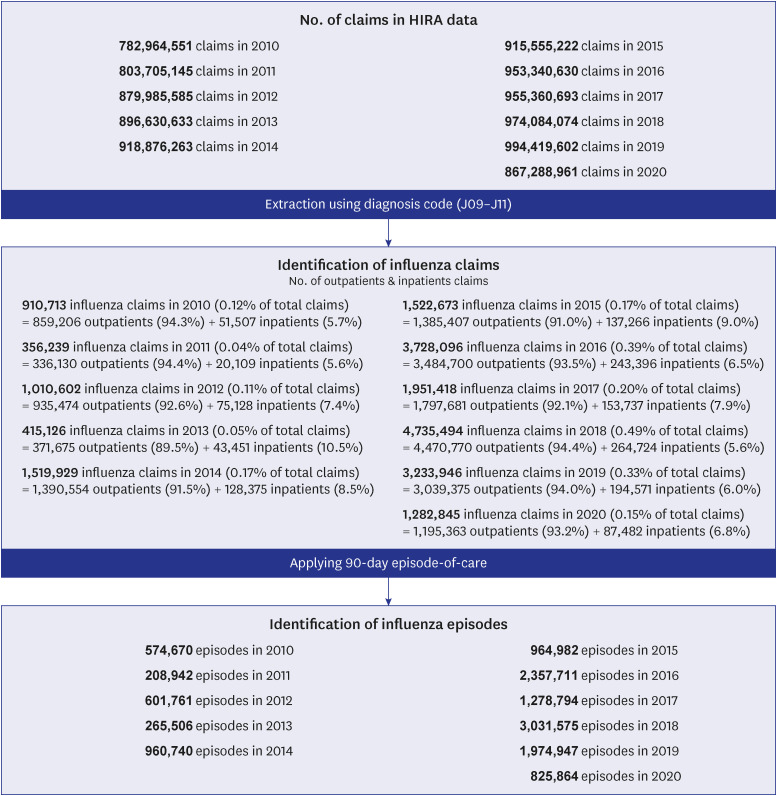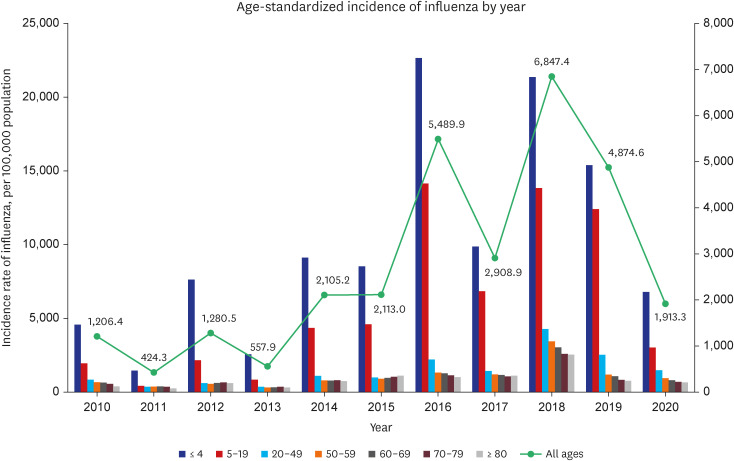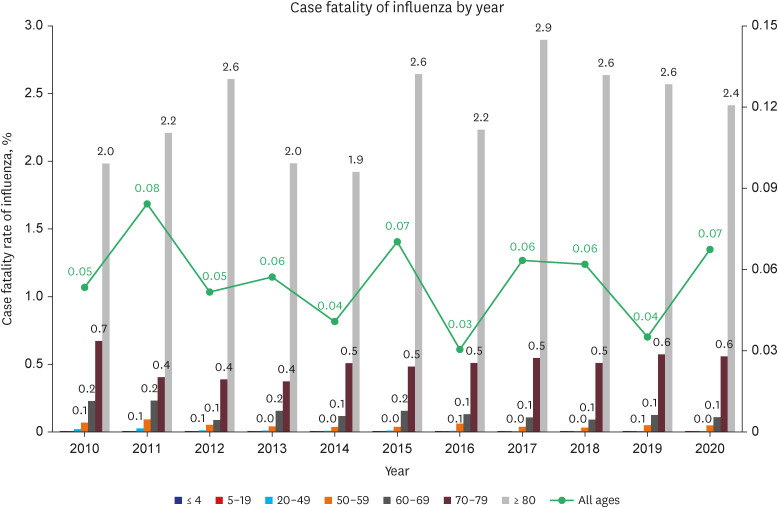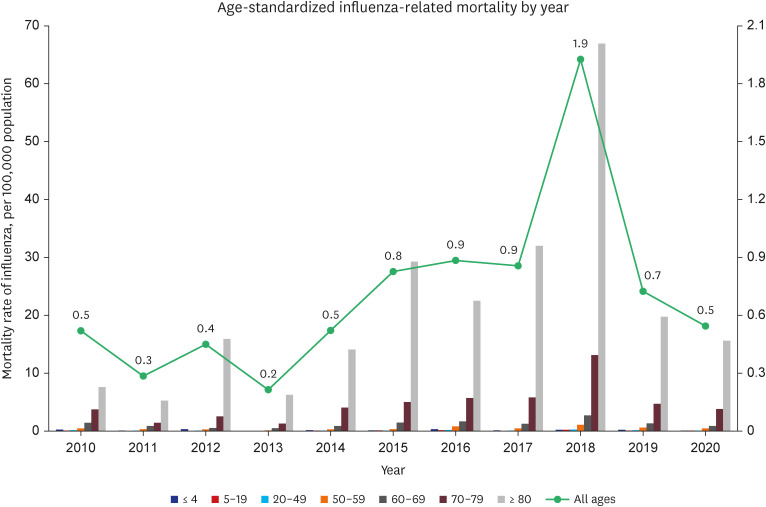J Korean Med Sci.
2023 Feb;38(8):e58. 10.3346/jkms.2023.38.e58.
Incidence, Severity, and Mortality of Influenza During 2010–2020 in Korea: A Nationwide Study Based on the Population-Based National Health Insurance Service Database
- Affiliations
-
- 1HIRA Research Institute, Health Insurance Review & Assessment Service, Wonju, Korea
- 2Department of Family Medicine, Seoul National University Bundang Hospital, Seongnam, Korea
- 3Department of Family medicine, Seoul National University College of Medicine, Seoul, Korea
- 4National Emergency Medical Center, National Medical Center, Seoul, Korea
- 5Department of Internal Medicine, Seoul National University College of Medicine, Seoul, Korea
- 6Department of Health Policy and Management, Seoul National University College of Medicine, Seoul, Korea
- 7Public Healthcare Center, Seoul National University Hospital, Seoul, Korea
- KMID: 2539631
- DOI: http://doi.org/10.3346/jkms.2023.38.e58
Abstract
- Background
The epidemiology of influenza is commonly used to understand and establish relevant health policies for emerging respiratory infections, including coronavirus disease 2019 (COVID-19). However, Korea has no confirmed nationwide data on influenza incidence, severity, and mortality rate.
Methods
We conducted a cross-sectional study to obtain epidemic data on influenza at the national level using National Health Insurance claims data during 2010 to 2020. Influenza cases were defined as 90-day timeframe episodes based on all inpatient and outpatient claims data with disease code J09, J10, and J11. Influenza incidence, severity, and mortality rate were calculated, and logistic regressions were performed to assess the associations of demographic characteristics and comorbidity with influenza-related hospitalization, severe illness, and death.
Results
There were 0.3–5.9% influenza cases in the population from 2010 to 2020, with 9.7–18.9%, 0.2–0.9%, and 0.03–0.08% hospitalized, used in the intensive care unit, and dead, respectively. Age-standardized incidence and mortality rates were 424.3–6847.4 and 0.2–1.9 per 100,000 population, respectively. While more than half of the influenza cases occurred in populations aged younger than 20 years, deaths in older than 60 years accounted for more than two-thirds of all deaths.
Conclusion
This study provided the simplest but most important statistics regarding Korean influenza epidemics as a reference. These can be used to understand and manage other new acute respiratory diseases, including COVID-19, and establish influenza-related policies.
Figure
Reference
-
1. Piroth L, Cottenet J, Mariet AS, Bonniaud P, Blot M, Tubert-Bitter P, et al. Comparison of the characteristics, morbidity, and mortality of COVID-19 and seasonal influenza: a nationwide, population-based retrospective cohort study. Lancet Respir Med. 2021; 9(3):251–259. PMID: 33341155.2. World Health Organization coronavirus disease 2019 (COVID-19) situation report - 46. Updated 2020. Accessed June 3, 2022. https://www.who.int/docs/default-source/coronaviruse/situation-reports/20200306-sitrep-46-covid-19.pdf .3. Xie Y, Bowe B, Maddukuri G, Al-Aly Z. Comparative evaluation of clinical manifestations and risk of death in patients admitted to hospital with covid-19 and seasonal influenza: cohort study. BMJ. 2020; 371:m4677. PMID: 33323357.4. Faust JS, Del Rio C. Assessment of deaths from COVID-19 and from seasonal influenza. JAMA Intern Med. 2020; 180(8):1045–1046. PMID: 32407441.
Article5. Papadakis M. Why comparing coronavirus disease 2019 (COVID-19) and seasonal influenza fatality rates is like comparing apples to pears. Infect Control Hosp Epidemiol. 2022; 43(7):958–959. PMID: 33820593.
Article6. Lee H, Sung HK, Lee D, Choi Y, Lee JY, Lee JY, et al. Comparison of complications after coronavirus disease and seasonal influenza, South Korea. Emerg Infect Dis. 2022; 28(2):347–353. PMID: 35076368.
Article7. World Health Organization. Influenza (seasonal). Updated 2018. Accessed June 3, 2022. https://www.who.int/en/news-room/fact-sheets/detail/influenza-(seasonal) .8. Iuliano AD, Roguski KM, Chang HH, Muscatello DJ, Palekar R, Tempia S, et al. Estimates of global seasonal influenza-associated respiratory mortality: a modelling study. Lancet. 2018; 391(10127):1285–1300. PMID: 29248255.9. GBD 2017 Influenza Collaborators. Mortality, morbidity, and hospitalisations due to influenza lower respiratory tract infections, 2017: an analysis for the Global Burden of Disease Study 2017. Lancet Respir Med. 2019; 7(1):69–89. PMID: 30553848.10. Whitelaw K. Europe slowly starts to consider treating covid like the flu. Bloomberg News [Internet]. Updated January 11, 2022. Accessed May 15, 2022. https://www.bloomberg.com/news/articles/2022-01-11/omicron-has-spain-looking-past-pandemic-as-europe-surge-persists .11. Paton J. Is covid becoming endemic? What would that mean? The Washington Post [Internet]. Updated January 11, 2022. Accessed May 15, 2022. https://www.washingtonpost.com/business/is-covid-becoming-endemic-what-would-that-mean/2022/01/19/9dd7066a-791c-11ec-9dce-7313579de434_story.html .12. Lee H, Lee JR, Jung H, Lee JY. Power of universal health coverage in the era of COVID-19: a nationwide observational study. Lancet Reg Health West Pac. 2021; 7:100088. PMID: 33521744.
Article13. Kyoung DS, Kim HS. Understanding and utilizing claim data from the Korean National Health Insurance Service (NHIS) and Health Insurance Review & Assessment (HIRA) database for research. J Lipid Atheroscler. 2022; 11(2):103–110. PMID: 35656154.
Article14. Statistics Korea. Information of the resident registration population. Updated 2022. Accessed June 25, 2022. https://kosis.kr/statHtml/statHtml.do?orgId=101&tblId=DT_1B040M5 .15. Wang Y, Fan G, Horby P, Hayden F, Li Q, Wu Q, et al. Comparative outcomes of adults hospitalized with seasonal influenza A or B virus infection: application of the 7-category ordinal scale. Open Forum Infect Dis. 2019; 6(3):ofz053. PMID: 30895200.
Article16. Beigel JH, Tebas P, Elie-Turenne MC, Bajwa E, Bell TE, Cairns CB, et al. Immune plasma for the treatment of severe influenza: an open-label, multicentre, phase 2 randomised study. Lancet Respir Med. 2017; 5(6):500–511. PMID: 28522352.
Article17. World Health Organization COVID-19 therapeutic trial synopsis. Updated 2020. Accessed June 25, 2022. https://www.who.int/docs/default-source/blue-print/covid-19-therapeutic-trial-synopsis.pdf .18. WHO Working Group on the Clinical Characterisation and Management of COVID-19 Infection. A minimal common outcome measure set for COVID-19 clinical research. Lancet Infect Dis. 2020; 20(8):e192–e197. PMID: 32539990.19. Zanobini P, Bonaccorsi G, Lorini C, Haag M, McGovern I, Paget J, et al. Global patterns of seasonal influenza activity, duration of activity and virus (sub)type circulation from 2010 to 2020. Influenza Other Respi Viruses. 2022; 16(4):696–706.20. Noda T. Incidence Rate of Seasonal Influenza Calculated from Japanese Medical Database. Tokyo, Japan: Ministry of Health, Labour and Welfare of Japan;2022.21. Tokars JI, Olsen SJ, Reed C. Seasonal incidence of symptomatic influenza in the United States. Clin Infect Dis. 2018; 66(10):1511–1518. PMID: 29206909.
Article22. Reed C, Chaves SS, Daily Kirley P, Emerson R, Aragon D, Hancock EB, et al. Estimating influenza disease burden from population-based surveillance data in the United States. PLoS One. 2015; 10(3):e0118369. PMID: 25738736.23. Centers for Disease Control and Prevention. Disease burden of flu. Updated 2022. Accessed June 25, 2022. https://www.cdc.gov/flu/about/burden/index.html .24. Centers for Disease Control and Prevention. How CDC estimates the burden of seasonal influenza in the U.S. Updated 2019. Accessed August 5, 2022. https://www.cdc.gov/flu/about/burden/how-cdc-estimates.htm .25. Korea Disease Control and Prevention Agency. 2020–2021 season influenza management guideline. Updated 2020. Accessed August 5, 2022. https://www.kdca.go.kr/board/board.es?mid=a20507020000&bid=0019&act=view&list_no=711042 .26. Choi WS. The national influenza surveillance system of Korea. Infect Chemother. 2019; 51(2):98–106. PMID: 31270989.
Article27. Choi H, Choi WS, Han E. Suggestion of a simpler and faster influenza-like illness surveillance system using 2014-2018 claims data in Korea. Sci Rep. 2021; 11(1):11243. PMID: 34045533.
Article28. Hong K, Sohn S, Chun BC. Estimating influenza-associated mortality in Korea: the 2009-2016 seasons. J Prev Med Public Health. 2019; 52(5):308–315. PMID: 31588700.
Article29. Choi WS, Cowling BJ, Noh JY, Song JY, Wie SH, Lee JS, et al. Disease burden of 2013-2014 seasonal influenza in adults in Korea. PLoS One. 2017; 12(3):e0172012. PMID: 28278158.
Article30. Park M, Wu P, Goldstein E, Joo Kim W, Cowling BJ. Influenza-associated excess mortality in South Korea. Am J Prev Med. 2016; 50(4):e111–e119. PMID: 26610897.
Article31. Korea Disease Control and Prevention Agency. Estimation of excess mortality associated with influenzas in Korea. Public Health Wkly Rep. 2021; 14(18):1150–1161.32. Byeon KH, Kim J, Choi BY, Kim JY, Lee N. Age-period-cohort analysis of influenza in Koreans: the national health insurance research database, 2009-2018. J Korean Med Sci. 2020; 35(18):e121. PMID: 32383364.33. Health Insurance Review & Assessment Service. Statistics on the diseases and Medical Practices in Daily Life. Wonju, Korea: Health Insurance Review & Assessment Service;2020.34. National Health Insurance Service. 2020 Healthy Life Information. Wonju, Korea: National Health Insurance Service;2020.35. Korea Disease Control and Prevention Agency. Infectious Disease Surveillance Yearbook, 2021. Osong, Korea: Korea Disease Control and Prevention Agency;2022.36. Simonsen L, Reichert TA, Viboud C, Blackwelder WC, Taylor RJ, Miller MA. Impact of influenza vaccination on seasonal mortality in the US elderly population. Arch Intern Med. 2005; 165(3):265–272. PMID: 15710788.37. Centers for Disease Control and Prevention. Influenza signs and symptoms and the role of laboratory diagnostics. Updated 2020. Accessed June 20, 2022. https://www.cdc.gov/flu/professionals/diagnosis/labrolesprocedures.htm .38. McCarthy Z, Athar S, Alavinejad M, Chow C, Moyles I, Nah K, et al. Quantifying the annual incidence and underestimation of seasonal influenza: a modelling approach. Theor Biol Med Model. 2020; 17(1):11. PMID: 32646444.
Article39. Macias AE, McElhaney JE, Chaves SS, Nealon J, Nunes MC, Samson SI, et al. The disease burden of influenza beyond respiratory illness. Vaccine. 2021; 39(Suppl 1):A6–14. PMID: 33041103.40. Schmidt SS, Iuliano AD, Vestergaard LS, Mazagatos-Ateca C, Larrauri A, Brauner JM, et al. All-cause versus cause-specific excess deaths for estimating influenza-associated mortality in Denmark, Spain, and the United States. Influenza Other Respi Viruses. 2022; 16(4):707–716.
Article
- Full Text Links
- Actions
-
Cited
- CITED
-
- Close
- Share
- Similar articles
-
- Incidence, Comorbidity, and Mortality of Primary Congenital Glaucoma in Korea from 2001 to 2015: A Nationwide Populationbased Study
- Incidence and Treatment Pattern of Extremity Soft Tissue Sarcoma in Korea, 2009-2011: A Nationwide Study Based on the Health Insurance Review and Assessment Service Database
- Data Analytic Process of a Nationwide Population-Based Study Using National Health Information Database Established by National Health Insurance Service
- The Prevalence and Incidence of Parkinson's Disease in South Korea: A 10-Year Nationwide Population: Based Study
- Factors Related to Institutionalization in Elderly With Dementia: Analysis of Nationwide Population-Based Data





